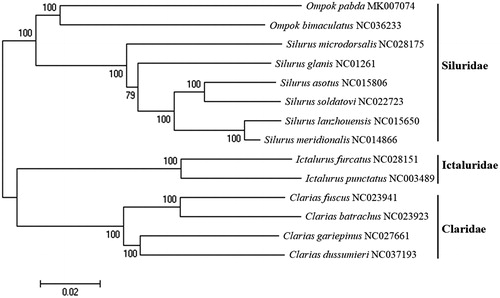Abstract
The complete mitochondrial genome of Pabdah catfish, Ompok pabda (Hamilton, 1822) was determined by MiSeq platform. The genome was 16,512 bp in length, in which canonical 13 protein-coding genes, 22 tRNAs, 2 rRNAs, and a control region (D-Loop) were encoded. The overall A + T (55.10%) content was higher than G + C (44.90%). Total nine genes were located at the L strand, and remaining 28 genes were at the H strand. The start codon of 12 protein-coding genes was ATG, except for COX1 (GTG). Incomplete stop codon (TA−/T–) was identified in six genes including COXII, COXIII, ND2, ND3, ND4, and Cytb. The mitogenome of O. pabda showed highest sequence identity with O. bimaculatus (86%).
The Pabdah catfish, Ompok pabda is a silurid fish, widely distributed in freshwaters of Bangladesh, Pakistan, India, Afghanistan, and Myanmar (Talwar and Jhingran Citation1991; Mukhopadhyay and Ghosh Citation2007). Although O. pabda has been considered as one of the most economically important catfish in Southeastern Asian countries, its population sharply declined due to the overexploitation, pollution, and destruction of habitat due to anthropogenic activities (Chakrabarti et al. Citation2009; Banik and Bhattacharya Citation2012; Chaklader et al. Citation2016). O. pabda is currently categorized as the endangered fish species in Bangladesh (Bangladesh Citation2000) and India (Molur and Walker Citation1998). O. pabda shares habitats with its relatives, such as Ompok pabo, and Ompok bimaculatus (Talwar and Jhingran Citation1991; Froese and Pauly Citation2011), their molecular identification would be an easy alternative way to manage their resources.
O. pabda was collected from the river in Khulna, Bangladesh (22°50′44.3′′ N, 89°32′27.7′′ E) in March 2017. The specimen was identified by its morphological characteristics and its identity of COI sequence in the NCBI database (GenBank number: KT762383). The specimen was stored in the Department of Fisheries and Marine Science laboratory, Noakhali Science and Technology University, Noakhali, Bangladesh. The full mitochondrial genome sequence of O. pabda was determined by next-generation sequencing (NGS) platform. Mitochondrial DNA was extracted by the mitochondrial DNA isolation kit (Abcam, Cambridge, UK) and the purified mitochondrial DNA was further fragmented into smaller sizes (∼350 bp) by Covaris M220 Focused-Ultrasonicator (Covaris Inc., Woburn, MA) . A library was constructed by TruSeq® RNA library preparation kit version 2 (Illumina, San Diego, CA), and its quality and the quantity was analysed by 2100 Bioanalyzer (Agilent Technologies, Inc., Santa Clara, CA). The high-throughput sequencing was performed by MiSeq system with 600-cycle kit (Illumina, San Diego, CA). Geneious R11 software (Kearse et al. Citation2012) was applied for the mitogenome assembly. Phylogenetic tree was constructed by MEGA version 7 software (Kumar et al. Citation2016) with minimum evolution (ME) algorithm.
The complete mitochondrial genome of O. pabda (GenBank Number: MK007074) was 16,512 bp in length, which consisted of 13 protein-coding genes, 22 tRNAs, two ribosomal RNAs (12S and 16S), and a control region (D-Loop). The overall composition of A + T (55.10%) was higher than the G + C (44.90%) content. Total nine genes were located at the L strand, whereas remaining 28 genes were at the H strand. Twelve protein-coding genes showed canonical start codon (ATG), while COX1 starts with GTG. Incomplete stop codon (TA−/T–) was identified in six genes including COXII, COXIII, ND2, ND3, ND4, and Cyt b. Based on the COI region, O. pabda was most closely related to O. pabo with 99% sequence identity (KX455911) followed by O. bimaculatus (88%, NC036233). Genus Ompok is recognized to be paraphyletic and O. pabda was clustered with the Siluridae family group.
The phylogenetic tree of O. pabda was constructed with other seven complete mitogenomes in Siluridae, two from Ictaluridae, and four from Claridae by MEGA version 7.0 program with ME algorithm (Kumar et al. Citation2016). Based on the full mitogenome sequences to the NCBI database, O. pabda showed the highest similarity to O. bimaculatus (GenBank number: NC036233) with 86% nucleotide sequence identity ().
Figure 1. Phylogenetic tree of Ompok pabda within Siluridae, Ictaluridae, and Claridae. Phylogenetic tree of Ompok pabda complete genome was constructed by MEGA version 7 software with minimum evolution (ME) algorithm with 1000 bootstrap replications. GenBank Accession numbers were shown followed by each species scientific name.

Disclosure statement
The authors report that they have no conflicts of interest. The authors alone are responsible for the content and writing of the article.
Additional information
Funding
References
- Bangladesh I. 2000. Red book of threatened fishes of Bangladesh. Bangladesh: IUCN-The World Conservation Union.
- Banik S, Bhattacharya P. 2012. Ompok pabo (Hamilton, 1822) of Tripura, India: an endangered fish species in relation to some biological parameters. Res J Biol. 2:91–97.
- Chaklader MR, Siddik MAB, Hanif MA, Nahar A, Mahmud S, Piria M. 2016. Morphometric and meristic variation of endangered pabda catfish, Ompok pabda (Hamilton-Buchanan, 1822) from southern coastal waters of Bangladesh. Pak J Zool. 48:681–687.
- Chakrabarti N, Chakrabarti P, Mondal S. 2009. Ompak bimaculatus and Ompak pabda comparative morphometric and meristic study of embryonic larval development. Fish Chim. 29:8–9.
- Froese R, Pauly D. 2011. FishBase. 2011. World-wide web electronic publication. [accessed 2011 Feb 22]. http://www/fishbase.org.
- Kearse M, Moir R, Wilson A, Stones-Havas S, Cheung M, Sturrock S, Buxton S, Cooper A, Markowitz S, Duran C, et al. 2012. Geneious basic: an integrated and extendable desktop software platform for the organization and analysis of sequence data. Bioinformatics. 28:1647–1649.
- Kumar S, Stecher G, Tamura K. 2016. MEGA7: molecular evolutionary genetics analysis version 7.0 for bigger datasets. Mol Biol Evol. 33:1870–1874.
- Molur S, Walker S. 1998. Report of the workshop on “Conservation assessment and management plan for freshwater fishes of India”. Tamil Nadu, India: CMFRI.
- Mukhopadhyay T, Ghosh S. 2007. Lipid profile and fatty acid composition of two silurid fish eggs. J Oleo Sci. 56:399–403.
- Talwar P, Jhingran A. 1991. Systematic account of Siluriformes fishes. Vol. 2. Inland Fishes of India and Adjacent Countries. Delhi, India: Oxford and IBH; p. 543–714.
